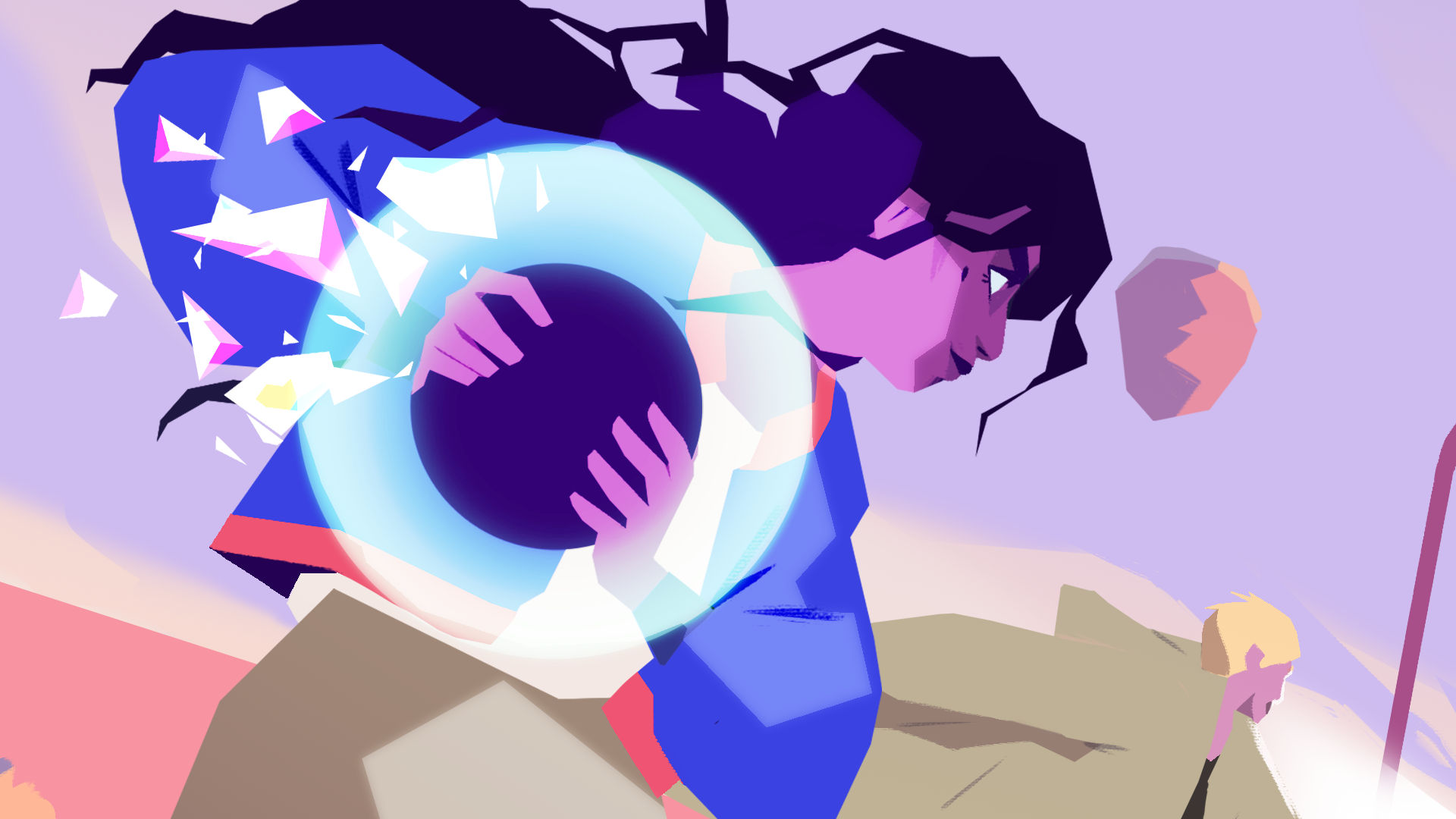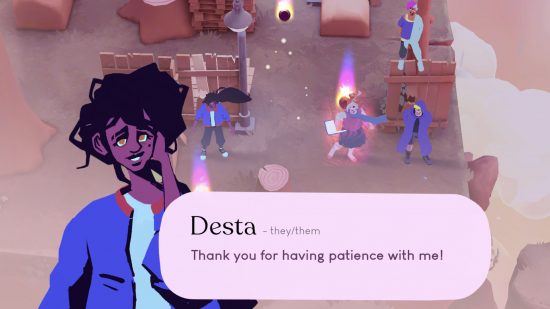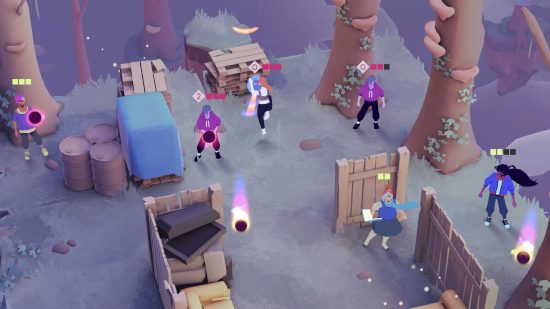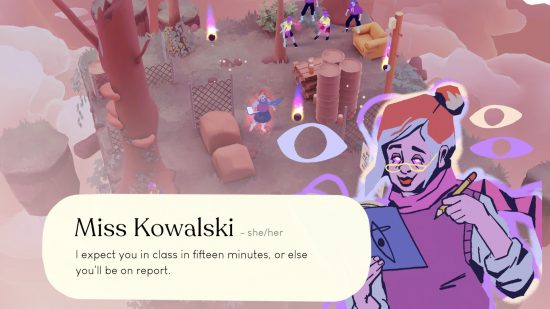After spending almost ten years developing Monument Valley and its sequel, ustwo games is back with its second original title, Desta: The Memories Between. This time round, it’s a roguelike strategy rather than an isometric puzzler, with the studio’s first non-binary protagonist, Desta, duty bound to spend every night dreaming their way through troubling memories that manifest in the form of tactical battles. Oh, and there’s dodgeball too, kind of.
The story of Desta is at the core of the experience, with each miniboss you encounter a lapsed relationship from our hero’s past, with their old friends, rave acquaintances, and secondary school teachers haunting their dreams before submitting to Desta’s charm and perpetually apologetic nature. It all seems to be leading up to a confrontation with Desta’s mum, who seemingly has a not-so-great relationship with her dreaming child since the loss of Desta’s dad.
The emotional core of the story is gripping, and you do want to see some sense of resolve for our hero’s fractured family. However, outside of Desta’s immediate family, and the third chapter’s Miss Kowalski, I have to admit I found the characters a little annoying. I’m not sure if this is my aversion to London-types – for reference, me playing Desta, having spent my whole life in the midlands of the UK, is the U.S. equivalent of playing through a New York or L.A. adventure having never left Rough Butt Creek, North Carolina. Fortunately, Desta themselves is captivating enough to carry the narrative, and it only gets better over time.
In terms of the overall tone of the game, Desta is decisively progressive, with all character pronouns displayed next to their names in text boxes, and a welcome diversity amongst the cast of characters. Better still, in a similar manner to what we found during our Bugsnax review, this cultural awareness never seems like virtue signalling. Instead, it creates a safe space for those who need it, while those who don’t can enjoy the tactical goodness without too much dialogue or exposition intrusion.
Onto that tactical goodness, and while I have to admit that the gameplay didn’t exactly hook me in the first hour or so, by the time you unlock a second character and start to learn some of the possible combos with special moves, it starts to feel like a proper strategy game, better still, one with real nuance. My eureka moment with Desta came on my second run, this is a roguelike after all, when I selected an ability that allows our hero to block the first enemy shot when they’re holding a ball, so I could get close up with my first movement, and use my second to bounce the ball off an opponent back at Desta, guaranteeing a hit on the enemy and a block for the next round.
From that point onwards, I found Desta’s strange combination of strategy battles and dodgeball more compelling than I thought I might, with a successful run keeping me awake a couple of hours later than I intended. I was having a great time, chucking speedballs at unaware enemies like Vince Vaughn taking on the Globo Gym, and then something hit me. Or rather, it didn’t. I hadn’t died in three hours.
Now I know what you’re thinking, “wow, Connor, your video game prowess is so potent that you can take on a roguelike just like that?” and you would be wrong, as much as I wish you weren’t. I love a strategy/tactical title, but I am hardly Napoleon when it comes to the art of war, and I’m not embarrassed to say that I’ve played late-game missions on easy mode in strategy titles before, and I’ll do it again. So, how had I made it three hours on what was only my second run?
To say that Desta is too easy might be a cop-out, but it would be good to see some difficulty options. This probably goes against ustwo Games’ core ethos, with the UI as clean and simplistic as it was across Monument Valley and its sequel, meaning that the endless menus you might associate with a strategy title are gone. This simplification adds to the easiness, and so after those three hours, I did start to want for more of a challenge. I’m not expecting the unforgiving tactical brutality of Into the Breach, but it feels like there needs to be a suped-up challenge, at least towards the end of the second chapter, to remind players that Desta is, in fact, a roguelike.
The dreamworld you find yourself in makes the suburbs of London look better than they do in real life, with a quaint pastel pallet for each subsection of levels. The layout is as imaginative as I expect you can create when limited to a grid for gameplay reasons, but Desta does a great job of placing obstacles, ammo, and healing tiles across its small field of play to make every movement feel like it matters. My only note here is that sometimes the clean and simple ustwo design method means some things are left unexplained, as I found out on my first run with Desta cornered by an enemy character with no hope of escape or keeping in their dreams.
I played on iPad and had no problems running the game in my few hours battling through the dreamscape streets of Desta’s London, but the controls still seem to need a little tweaking. On at least a couple of occasions, the aiming touch mechanics managed to freak out in the milliseconds before I attempted to launch a ball, with no redo allocated on your throw. In fact, aiming, in general, can be a bit hit or miss, and considering how precious a resource Desta’s dodgeballs are, it can be incredibly frustrating in a high-intensity situation when you accidentally lob a ball towards no one on the other side of the field.
All in all, ustwo Games should be pleased with the fruits of its labour on Desta. While it will have more competition as a console port, as far as strategy/tactical titles go on mobile, Netflix has secured a title for its platform that is easy to play and hard to put down, with a hearteningly sincere main character that will allow countless gamers to feel, potentially for the first time, as if they are at the crux of their own story.
Desta: The Memories Between is now available on Android and iOS via Netflix games. For more from ustwo games, check out our Monument Valley interview with one of the creators, or our Monument Valley 2 review for the last game out of the indie powerhouse.
Desta: The Memories Between review
While the core gameplay of Desta can deliver hours of entertainment thanks to nuanced core gameplay and a likeable lead, the touch controls can be a little frustrating and those looking for a challenge may be hard-pushed to find one out of the gate. Still, this game knows its demographic and those who belong to it are almost guaranteed to feel right at home in the dreamscape streets of Desta’s London.
7








